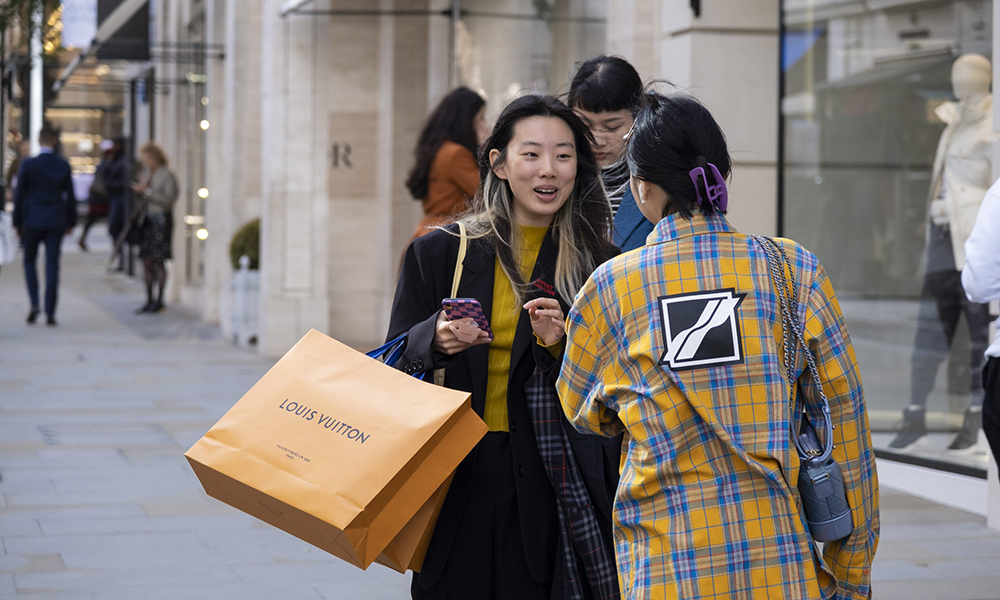 一位股票分析師對《財富》雜志表示:“你需要不斷從全新視角出發(fā),,滿足消費者需求,,給他們帶來驚喜和愉悅?!眻D片來源:MIKE KEMP - GETTY IMAGES
一位股票分析師對《財富》雜志表示:“你需要不斷從全新視角出發(fā),,滿足消費者需求,,給他們帶來驚喜和愉悅?!眻D片來源:MIKE KEMP - GETTY IMAGES韶華易逝,。盡管多年來表現(xiàn)強(qiáng)勁,但自2009年以來,,個人奢侈品市場今年首次出現(xiàn)放緩跡象,。貝恩公司(Bain & Company)最新發(fā)布的年度奢侈品報告警告稱,目前已有5000萬奢侈品消費者要么已經(jīng)停止購買名牌包,、圍巾,、手表等產(chǎn)品,要么已經(jīng)被過高的價格拒之門外,。
貝恩公司預(yù)測,,到年底時,僅有三分之一的奢侈品牌能夠?qū)崿F(xiàn)正增長,,這一比例較去年的三分之二有所下降,。
展望未來,該報告指出,,為了生存下去,,奢侈品牌需要重新評估自身的價值主張,尤其是針對Z世代消費者,,并不斷滿足他們?nèi)找嬖鲩L的期望,。
至于如何做?專注于奢侈品零售的股票分析師瑪麗·德里斯科爾(Marie Driscoll)告訴《財富》,,重塑是關(guān)鍵,。
德里斯科爾說:“回歸本質(zhì),讓產(chǎn)品更能激發(fā)靈感,,讓購物體驗更妙不可言,。你需要不斷從全新視角出發(fā),滿足消費者需求,,給他們帶來驚喜和愉悅,?!?/p>
德里斯科爾補(bǔ)充說:“再美味的圣代冰淇淋吃到第五個也會變得索然無味?!?/p>
違背對購物者的承諾
德里斯科爾說,,在某種程度上,品牌違背了對消費者的承諾,。
德里斯科爾補(bǔ)充說:“自2019年以來,,奢侈品的價格一直在大幅上漲,但其創(chuàng)新,、服務(wù),、質(zhì)量或吸引力卻沒有相應(yīng)提升。今年,,消費者受到了真正的沖擊,,我們充分感受到了這種影響?!?/p>
這或許可以解釋為何包括路威酩軒集團(tuán)(LVMH,,旗下?lián)碛械蠆W和路易威登)、博柏利(Burberry)和開云集團(tuán)(Kering,,旗下?lián)碛惺チ_蘭和古馳)在內(nèi)的奢侈品巨頭今年未能實現(xiàn)營收目標(biāo),。事實上,路威酩軒集團(tuán)在2023年9月就被司美格魯肽注射液諾和泰(Ozempic)的制造商諾和諾德(Novo Nordisk)取代,,成為歐洲市值最高的公司,。
消費者不僅因高端品牌令人咋舌的價格而望而卻步,而且他們的薪資水平也難以跟上這些產(chǎn)品價格的漲幅,。因此,消費者對這些高端品牌的產(chǎn)品可能越來越不感興趣,。
某些品牌所面臨的挑戰(zhàn)比其他品牌更為嚴(yán)峻,。邁克·高仕(Michael Kors)是同名品牌的創(chuàng)始人,他在今年9月的紐約時裝周上表示,,他正努力應(yīng)對“品牌疲勞”,,并將此作為品牌營收同比下降14%的原因之一。他還將原因歸咎于快時尚和社交媒體上的網(wǎng)紅對潮流的反應(yīng)速度要快得多,。
零售業(yè)分析師希塔·赫爾佐格(Hitha Herzog)告訴《財富》雜志:“奢侈品消費者追求的是稀缺性,、獨特性、定制化,、精致度以及專屬性,。雖然部分奢侈品牌提供基本的定制服務(wù),但絕大多數(shù)奢侈品牌都無法為VIP客戶制作獨一無二的單品,,或者創(chuàng)造一些讓追求高品質(zhì)生活的客戶努力爭取最終擁有的珍品,?!?/p>
但有一個重要的例外:愛馬仕(Hermés)。盡管許多同行品牌舉步維艱,,但愛馬仕今年業(yè)績增長迅猛,。赫爾佐格說,這在很大程度上要歸功于柏金包,,因為這款手袋“在顧客與店家商討購買之前,,必須經(jīng)歷漫長的等待時間、滿足一定的要求,,并達(dá)到一定的消費金額基準(zhǔn)”,。赫爾佐格說,這種獨有性“創(chuàng)造了一種擁有稀有物品的神秘感,,當(dāng)你看到價格標(biāo)簽時,,就會覺得它物有所值”。
中國效應(yīng)
自2000年以來,,中國一直是全球奢侈品市場增長的主要推動力,,直到疫情爆發(fā)。德里斯科爾說:“全球奢侈品的增長得益于中國中產(chǎn)階級,、追求高品質(zhì)生活階層和百萬富翁人群的增長,。”
奢侈品行業(yè)的領(lǐng)軍企業(yè)路威酩軒集團(tuán)上個月公布收入下降3%,,這在很大程度上可以歸因于通貨膨脹對消費者行為的持續(xù)影響,,尤其是在至關(guān)重要的中國市場。就開云集團(tuán)而言,,該公司上個月的營收同比下降了15%,。
貝恩公司表示,中國市場消費銳減是由于“消費者信心不足”,,這一觀點并非貝恩公司獨有,。
波士頓咨詢公司(BCG)的奢侈品業(yè)務(wù)合伙人尼古拉斯·利納斯-卡里佐薩(Nicolas Llinas-Carrizosa)告訴《財富》雜志,從全球來看,,當(dāng)前的經(jīng)濟(jì)環(huán)境使許多追求高品質(zhì)生活的購物者在消費方面更為保守,。“他們要么優(yōu)先考慮金融投資,,要么優(yōu)先考慮他們認(rèn)為更重要的其他類別的支出,。”
貝恩公司表示,,總而言之,,整個奢侈品行業(yè)在2024年全年將下降2%。
但這并不意味著消費者完全停止消費,;旅游,、高級葡萄酒和餐飲以及汽車行業(yè)今年都出現(xiàn)了溫和增長,。
此外,中國,、歐洲,、美國,尤其是日本,,仍有望在2025年底實現(xiàn)“逐步復(fù)蘇”——在日本,,購物者因有利匯率而成為幸運受益者。(財富中文網(wǎng))
譯者:中慧言-王芳
韶華易逝,。盡管多年來表現(xiàn)強(qiáng)勁,,但自2009年以來,個人奢侈品市場今年首次出現(xiàn)放緩跡象,。貝恩公司(Bain & Company)最新發(fā)布的年度奢侈品報告警告稱,,目前已有5000萬奢侈品消費者要么已經(jīng)停止購買名牌包、圍巾,、手表等產(chǎn)品,,要么已經(jīng)被過高的價格拒之門外。
貝恩公司預(yù)測,,到年底時,,僅有三分之一的奢侈品牌能夠?qū)崿F(xiàn)正增長,這一比例較去年的三分之二有所下降,。
展望未來,,該報告指出,為了生存下去,,奢侈品牌需要重新評估自身的價值主張,,尤其是針對Z世代消費者,并不斷滿足他們?nèi)找嬖鲩L的期望,。
至于如何做,?專注于奢侈品零售的股票分析師瑪麗·德里斯科爾(Marie Driscoll)告訴《財富》,重塑是關(guān)鍵,。
德里斯科爾說:“回歸本質(zhì),讓產(chǎn)品更能激發(fā)靈感,,讓購物體驗更妙不可言,。你需要不斷從全新視角出發(fā),滿足消費者需求,,給他們帶來驚喜和愉悅,。”
德里斯科爾補(bǔ)充說:“再美味的圣代冰淇淋吃到第五個也會變得索然無味,?!?/p>
違背對購物者的承諾
德里斯科爾說,,在某種程度上,品牌違背了對消費者的承諾,。
德里斯科爾補(bǔ)充說:“自2019年以來,,奢侈品的價格一直在大幅上漲,但其創(chuàng)新,、服務(wù),、質(zhì)量或吸引力卻沒有相應(yīng)提升。今年,,消費者受到了真正的沖擊,,我們充分感受到了這種影響?!?/p>
這或許可以解釋為何包括路威酩軒集團(tuán)(LVMH,,旗下?lián)碛械蠆W和路易威登)、博柏利(Burberry)和開云集團(tuán)(Kering,,旗下?lián)碛惺チ_蘭和古馳)在內(nèi)的奢侈品巨頭今年未能實現(xiàn)營收目標(biāo),。事實上,路威酩軒集團(tuán)在2023年9月就被司美格魯肽注射液諾和泰(Ozempic)的制造商諾和諾德(Novo Nordisk)取代,,成為歐洲市值最高的公司,。
消費者不僅因高端品牌令人咋舌的價格而望而卻步,而且他們的薪資水平也難以跟上這些產(chǎn)品價格的漲幅,。因此,,消費者對這些高端品牌的產(chǎn)品可能越來越不感興趣。
某些品牌所面臨的挑戰(zhàn)比其他品牌更為嚴(yán)峻,。邁克·高仕(Michael Kors)是同名品牌的創(chuàng)始人,,他在今年9月的紐約時裝周上表示,他正努力應(yīng)對“品牌疲勞”,,并將此作為品牌營收同比下降14%的原因之一,。他還將原因歸咎于快時尚和社交媒體上的網(wǎng)紅對潮流的反應(yīng)速度要快得多。
零售業(yè)分析師希塔·赫爾佐格(Hitha Herzog)告訴《財富》雜志:“奢侈品消費者追求的是稀缺性,、獨特性,、定制化、精致度以及專屬性,。雖然部分奢侈品牌提供基本的定制服務(wù),,但絕大多數(shù)奢侈品牌都無法為VIP客戶制作獨一無二的單品,或者創(chuàng)造一些讓追求高品質(zhì)生活的客戶努力爭取最終擁有的珍品,?!?/p>
但有一個重要的例外:愛馬仕(Hermés)。盡管許多同行品牌舉步維艱,,但愛馬仕今年業(yè)績增長迅猛,。赫爾佐格說,,這在很大程度上要歸功于柏金包,因為這款手袋“在顧客與店家商討購買之前,,必須經(jīng)歷漫長的等待時間,、滿足一定的要求,并達(dá)到一定的消費金額基準(zhǔn)”,。赫爾佐格說,,這種獨有性“創(chuàng)造了一種擁有稀有物品的神秘感,當(dāng)你看到價格標(biāo)簽時,,就會覺得它物有所值”,。
中國效應(yīng)
自2000年以來,中國一直是全球奢侈品市場增長的主要推動力,,直到疫情爆發(fā),。德里斯科爾說:“全球奢侈品的增長得益于中國中產(chǎn)階級、追求高品質(zhì)生活階層和百萬富翁人群的增長,?!?/p>
奢侈品行業(yè)的領(lǐng)軍企業(yè)路威酩軒集團(tuán)上個月公布收入下降3%,這在很大程度上可以歸因于通貨膨脹對消費者行為的持續(xù)影響,,尤其是在至關(guān)重要的中國市場,。就開云集團(tuán)而言,該公司上個月的營收同比下降了15%,。
貝恩公司表示,,中國市場消費銳減是由于“消費者信心不足”,這一觀點并非貝恩公司獨有,。
波士頓咨詢公司(BCG)的奢侈品業(yè)務(wù)合伙人尼古拉斯·利納斯-卡里佐薩(Nicolas Llinas-Carrizosa)告訴《財富》雜志,,從全球來看,當(dāng)前的經(jīng)濟(jì)環(huán)境使許多追求高品質(zhì)生活的購物者在消費方面更為保守,?!八麄円磧?yōu)先考慮金融投資,要么優(yōu)先考慮他們認(rèn)為更重要的其他類別的支出,?!?/p>
貝恩公司表示,總而言之,,整個奢侈品行業(yè)在2024年全年將下降2%,。
但這并不意味著消費者完全停止消費;旅游,、高級葡萄酒和餐飲以及汽車行業(yè)今年都出現(xiàn)了溫和增長。
此外,,中國,、歐洲,、美國,尤其是日本,,仍有望在2025年底實現(xiàn)“逐步復(fù)蘇”——在日本,,購物者因有利匯率而成為幸運受益者。(財富中文網(wǎng))
譯者:中慧言-王芳
Nothing gold can stay. Despite years of strong performance, the market for personal luxury goods is set to slow down this year for the first time since the 2009 Great Recession. Now, 50 million luxury consumers have either ditched buying designer bags, scarves, watches, and more—or have been priced out, Bain & Company’s new annual luxury report warns.
Only a third of luxury brands will end the year with positive growth, Bain posited, down from two-thirds last year.
Looking ahead, it said that to stay alive, brands need to reevaluate their value proposition—mainly for Gen Zers—and keep meeting their growing expectations.
As for how? Marie Driscoll, an equity analyst focused on luxury retail, told Fortune that reinvention is key.
“Get back to books, make products more inspirational, make the shopping experience marvelous,” Driscoll said. “You need to constantly meet consumers at a new angle and surprise and delight them.”
“A fabulous ice cream sundae is boring by the time you have it the fifth time,” Driscoll added.
Broken promises to shoppers
On some level, brands have broken their promises to consumers, Driscoll said.
“Since 2019, there’s been a high price increase across luxury without a corresponding increase in innovation, service, quality, or appeal that a luxury brand should provide,” Driscoll added. “This year, that really hit consumers, and we felt the full impact.”
It perhaps explains why the luxury powerhouses, including LVMH (which owns Dior and Louis Vuitton), Burberry, and Kering (owner of YSL and Gucci), missed revenue targets this year. In fact, LVMH was dethroned as Europe’s most valuable company in September 2023 by Novo Nordisk, the maker of Ozempic.
Customers—beyond being hamstrung by eye-popping prices with which their salaries rarely keep pace—are likely growing unimpressed by the products these high-end brands have to offer.
Some more than others. Michael Kors, founder of his namesake brand, said during New York Fashion Week in September that he’s struggling with “brand fatigue” in an effort to explain 14% year-over-year revenue drops, pointing his finger at fast fashion and social media influencers keeping up with trends much, much faster.
“The luxury consumer wants something that is rare, unique, bespoke, beautiful and specifically theirs,” Hitha Herzog, a retail analyst, told Fortune. “While some luxury brands offer basic customization, almost all luxury brands have no way to make one-off pieces for their VIP clients, or create something so aspirational customers can strive to eventually own.”
One major exception: Hermés, which has skyrocketed in growth this year while its industry peers have struggled. Herzog said this is largely thanks to its Birkin bag, which amasses “l(fā)ong waitlists and requirements and benchmarks of how much money a customer spends before they can talk to the store about purchasing a bag.” That exclusivity, Herzog said, “creates a mystique around owning something rare, and gives it a sense of worth when you look at the price tag.”
The China effect
China had been propelling luxury growth since 2000 all the way until the pandemic. “Luxury growth globally benefited from the growth of the Chinese middle class, the aspirational class, and the people that became millionaires,” Driscoll said.
LVMH, a bellwether for the larger luxury space, posted a 3% revenue drop last month, due in large part to the continued impacts of inflation on consumer behavior—especially in the crucial Chinese market. For its part, Kering reported a 15% year-over-year decline last month.
Bain said the sharp decrease in spending in China is due to “l(fā)ackluster consumer confidence”—and they’re not alone.
Globally, the current economic environment has made many “aspirational” shoppers more conservative in their spending, Nicolas Llinas-Carrizosa, a BCG partner focused on luxury, told Fortune. “They’re prioritizing either financial investments or prioritizing spending in other categories they deem more important to them.”
All told, the entire luxury sector is set to drop by 2% over the 2024 full-year period, Bain said.
But that doesn’t mean consumers are pausing their spending altogether; the travel, fine wine and dining, and auto sectors both reported modest growth this year.
Plus a “gradual recovery” in late 2025 is nonetheless still likely in China, Europe, the U.S. and especially Japan—where shoppers are the lucky beneficiary of favorable currency exchange rates.






